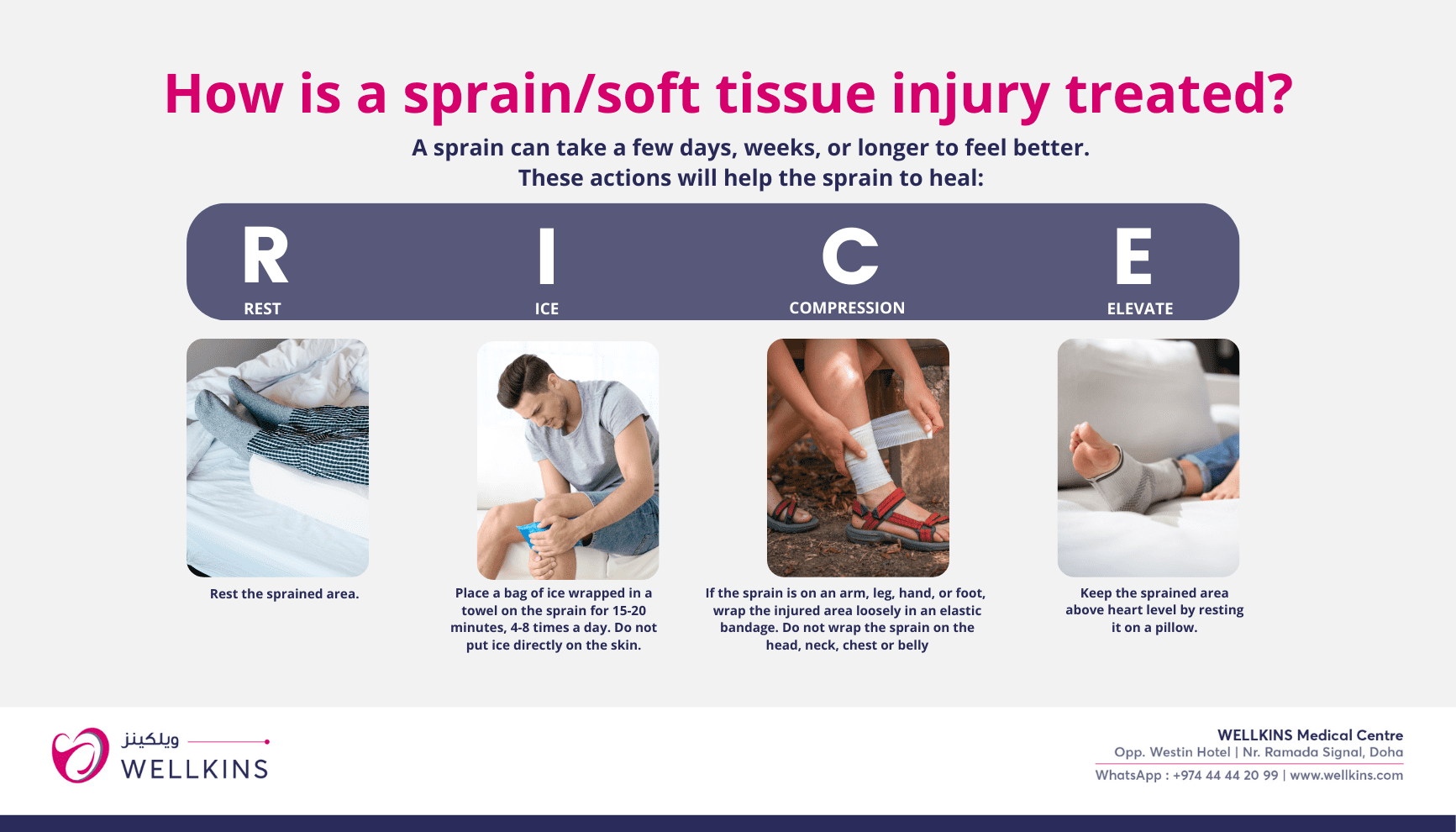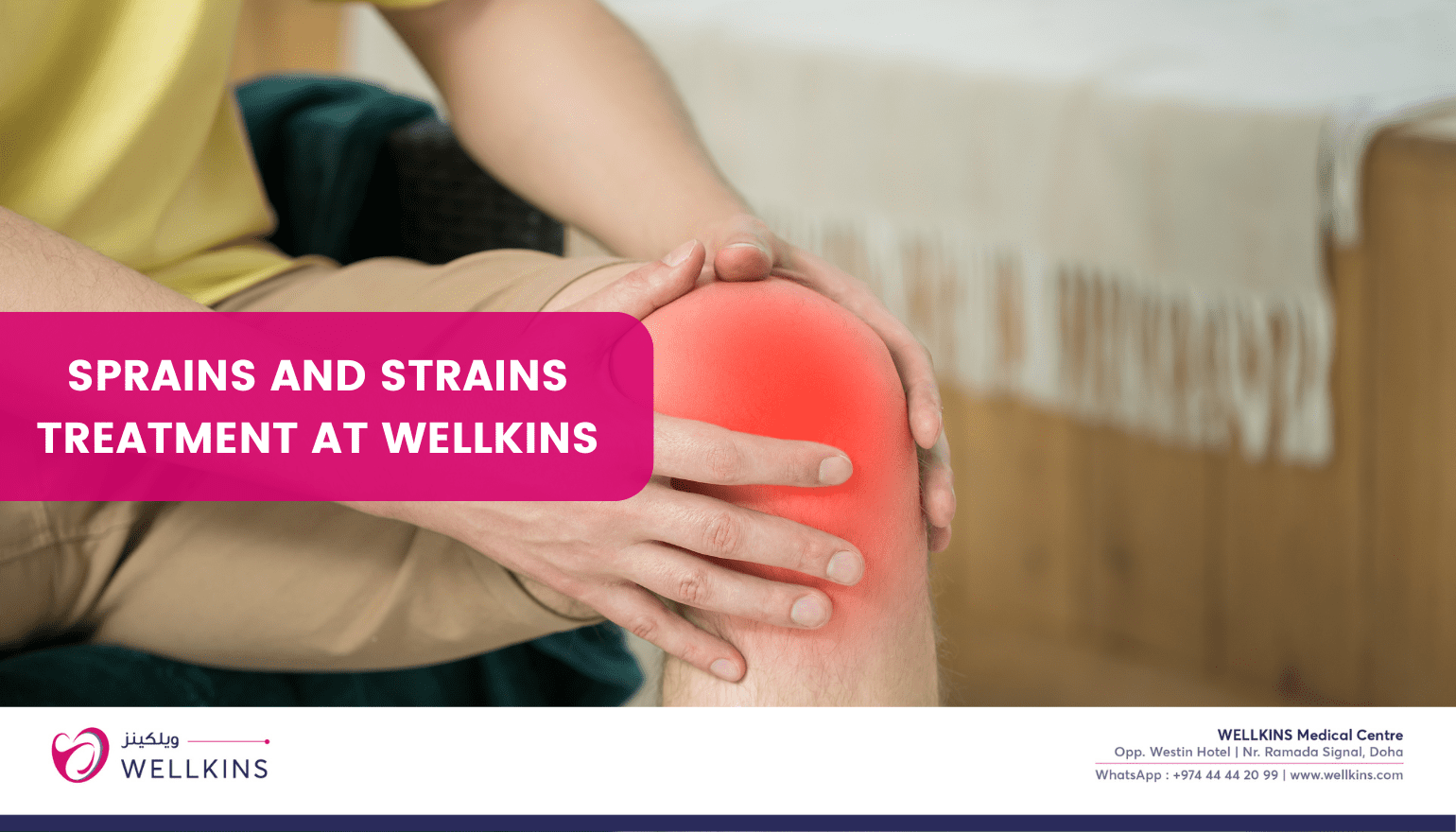Author: Dr.Reneesh (Consultant Orthopedic Surgeon – WELLKINS Medical Centre)
Sprains and strains are some of the most common injuries I see as an orthopedic surgeon. While treatment plays a critical role in recovery, the importance of nutrition is often overlooked. Optimal healing depends on a combination of medical care and the right nutrients to help rebuild damaged tissues.
Consuming a diet rich in calcium, vitamin D, protein, and antioxidants is essential for post-fracture recovery. These nutrients support bone healing, reduce inflammation, and boost the immune system, promoting optimal recovery and preventing complications.
Understanding Sprains and Strains
Sprains: Injuries to ligaments (the fibrous tissues connecting bones at a joint), caused by overstretching or tearing, often due to sudden twists or impacts.
Strains: Injuries to muscles or tendons (which connect muscles to bones), caused by overstretching or tearing due to overuse or sudden force.
Treatment of Sprains and Strains at WELLKINS
Acute Phase (First 48–72 Hours)
Immediate care in this phase is crucial for minimizing damage, reducing pain, and promoting healing.

RICE Protocol:
Rest: Avoid putting weight or stress on the injured area to prevent further damage.
Ice: Apply ice for 15–20 minutes every 2–3 hours to reduce swelling and numb pain.
Compression: Use an elastic bandage to compress the area and reduce swelling.
Elevation: Elevate the injured limb above heart level to minimize fluid buildup.
Medications:
Nonsteroidal Anti-Inflammatory Drugs (NSAIDs): Medications like ibuprofen can reduce inflammation and pain. However, long-term use of NSAIDs should be monitored, as they may interfere with tissue healing.
Immobilization:
For moderate to severe sprains or strains, immobilization using a brace, splint, or sling may be required for a short period to allow healing.
Physical Therapy:
Once the acute phase has passed, rehabilitation through physical therapy is key to restoring strength, flexibility, and joint stability. A gradual program tailored to the patient’s needs helps reduce stiffness, improve mobility, and prevent re-injury. Strengthening exercises for muscles surrounding the injured area promote stability and long-term recovery. Balance and proprioception training are essential for joint stabilization, especially after ankle or knee sprains.
Surgical Intervention:
In cases of severe Grade III sprains (complete ligament tears) or strains (complete tendon ruptures), surgery may be necessary to repair the damaged tissues.
Post-surgical rehabilitation is crucial to ensure proper healing and return to normal function.
Nutrition for Recovery
While medical treatment is essential for sprains and strains, nutrition plays a vital role in speeding up recovery and ensuring optimal tissue repair.
1. Protein
Role: Protein is the building block of muscle, ligament, and tendon tissue. It supports the repair of damaged fibers and helps in muscle regeneration.
Sources: Lean meats (chicken, turkey, fish), eggs, dairy products, tofu, legumes, nuts, and seeds.
2. Omega-3 Fatty Acids
Role: Omega-3 fatty acids have anti-inflammatory properties, which can help reduce swelling and pain. They also support the regeneration of tissue.
Sources: Fatty fish (salmon, mackerel, sardines), flaxseeds, chia seeds, and walnuts.
3. Vitamin C
Role: Vitamin C is essential for collagen production, which is vital for the repair of ligaments, tendons, and muscles. It also acts as an antioxidant, helping to reduce inflammation.
Sources: Citrus fruits (oranges, lemons), strawberries, bell peppers, broccoli, and kale.
4. Zinc
Role: Zinc supports tissue repair and boosts the immune system. It plays a key role in protein synthesis and cell division, which are crucial for healing.
Sources: Red meat, poultry, beans, nuts, whole grains, and dairy products.
5. Calcium and Vitamin D
Role: While calcium is primarily known for bone health, it also plays a role in muscle function and recovery. Vitamin D helps the body absorb calcium efficiently.
Sources of Calcium: Dairy products (milk, yogurt, cheese), leafy green vegetables, almonds, and fortified plant-based milk.
Sources of Vitamin D: Sunlight exposure, fatty fish, egg yolks, fortified dairy products, and mushrooms.
6. Magnesium
Role: Magnesium is critical for muscle function, relaxation, and repair. It helps reduce muscle cramps and supports overall healing.
Sources: Leafy green vegetables, nuts, seeds, whole grains, and legumes.
7. B Vitamins
Role: B vitamins, especially B6 and B12, are important for energy production and red blood cell formation. They help with muscle repair and reduce fatigue during recovery.
Sources: Poultry, fish, eggs, dairy, whole grains, and fortified cereals.
8. Hydration
Role: Proper hydration ensures efficient nutrient delivery to tissues and helps remove toxins from injured areas. Dehydration can delay healing and increase the risk of muscle cramps.
Sources: Water, herbal teas, and electrolyte drinks (low in sugar).
Combining Treatment and Nutrition for Optimal Recovery
When recovering from sprains and strains, medical treatment and rehabilitation are the primary interventions. However, incorporating the right nutrients into your diet can accelerate recovery, enhance tissue repair, and minimize complications. It’s important for patients to maintain a balanced diet rich in proteins, vitamins, and minerals to support the body’s natural healing process.
Practical Tips for Recovery
Follow the RICE protocol immediately after the injury to control swelling and pain.
Consult a healthcare professional to determine the severity of the injury and the best treatment plan.
Start physical therapy as soon as advised to regain strength and flexibility.
Incorporate nutrient-rich foods into your daily diet to support healing.
Avoid smoking and excessive alcohol consumption, as these can impair tissue healing.
The road to recovery from sprains and strains requires a combination of proper medical care and nutrition. As an orthopedic surgeon, I emphasize the importance of integrating both treatment and a nutrient-rich diet to optimize recovery, reduce inflammation, and promote long-term healing. With the right approach, most patients can fully recover and return to their regular activities without long-term complications.
Read more about the orthopedic services at wellkins here: https://wellkins.com/orthopedics/







